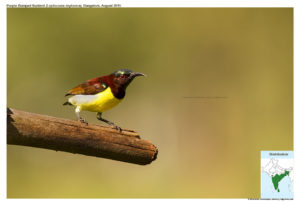Purple-rumped Sunbird

Purple-rumped Sunbird Leptocoma zeylonica
Etymology :
- Leptocoma : Greek word leptos –delicate, fine; kome – Hair
- Zeylonica: From Ceylon, modern Srilanka
Distribution in India: Widespread resident in Central and SouthIndia.
Description: Size of 10 cm; wt. of male is 7–11 g, wt. of female is 7–7·9 g. The male of nominate race has metallic green crown and shoulder patch, deep chestnut-maroon on side of head, nape and back, and metallic purple on rump and uppertail-coverts. The upperwing and tail are black, remiges are edged brown; metallic purple on throat bordered below by deep chestnut-maroon; breast and centre of belly are lemon-yellow, flanks are greyish-white, vent and undertail-coverts are yellowish-white, large pale grey terminal spots on outer rectrices; iris is orange-brown to reddish-brown; bill is brownish-black; legs are brownish or black. The female is brown with olive tinge above, narrow whitish supercilium, blackish eyestripe, rufous edging on remiges, large pale grey terminal spots on outer rectrices; throat and flanks are greyish-white, throat with buffy or slightly yellowish wash, breast and centre of belly are lemon-yellow. The juvenile is as female, but throat and whole underparts are very pale lemon-yellow. It is found in secondary forest, at forest edge, in farmland, dry cultivation, hedges, isolated trees, and gardens. It is found at lowlands to 2100 m.
Food habits: It eats insects, including caterpillars, also spiders,nectar and grapes and fruits. It drinks nectar from flowers having large corollas. It is very active and forages singly and in pairs.
Breeding habits: They breed in all months in India, Dec–Apr and Jul–Sept in South India, and Jun–Sept in West India; in all months in Sri Lanka.The male helps female in nest construction, one nest completed in 6 days. The nest is a pear-shaped or oval purse, usually with porch, constructed from grass, fibres and oddments, decorated externally with lichen, bark, moss, caterpillar frass, broken leaves and variety of other rubbish, lined with soft vegetable down, and suspended from tip of tree branch above ground, sometimes outside or inside dwelling, attached to creepers, trellis or wire. A new nest is constructed for each clutch. They lay a clutch of 2-3 eggs.The incubation is done by female, guarded at nest by male. The incubation period is 15–16 days. The chicks are fed by both sexes, both also remove faecal sacs. The nestling period is 11–14 days. The nest isparasitized by Plaintive Cuckoo.